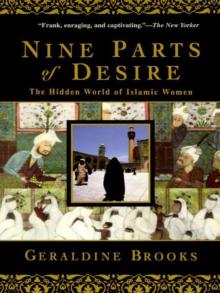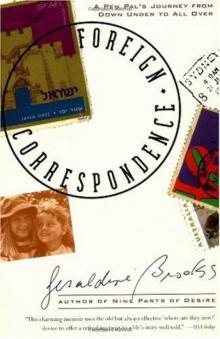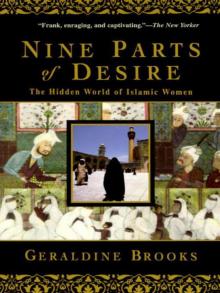- Home
- Geraldine Brooks
Nine Parts of Desire (Korean Edition) Page 13
Nine Parts of Desire (Korean Edition) Read online
Page 13
Chapter 6
JIHAD IS FOR WOMEN, TOO
“O true believers, if ye assist God, by fighting for his religion, he will assist you against your enemies; and will set your feet fast.”
THE KORAN
THE CHAPTER OF WAR
At first Hadra Dawish had trouble with the prone position on the rifle range. “I was always wondering, ‘Does my uniform cover me enough? Is there a man walking around behind me?’”
But five months later, when she graduated top of her class at the United Arab Emirates military academy, Hadra Dawish had learned to empty her mind of everything but the target. She had mastered the M-16 assault rifle, Russian rocket-propelled grenades, multipurpose machine guns, hand grenades and 9mm pistols. She knew how to rappel from a hovering helicopter and conduct a night reconnaissance patrol through desert terrain. In 1992 she became the first woman from an Arabian Gulf country to enroll for officer training at the British military academy, Sandhurst.
No one seemed more surprised by any of this than Hadra herself. She had been born in 1967 into one of the most conservative Muslim societies. In those days most women of the Emirates lived in strict seclusion. Outside the family they wore the long black abaya and a cloth veil over their faces. Even at home, many women wore the burka—a black and gold canvas or leather mask that conceals everything but the eyes. Sending a daughter to an all-girls school was considered a risky step: less than a decade ago, conservative families wouldn’t allow their sons to marry any girl who had been seen by anyone, man or woman, outside the family circle.
Hadra’s family had been progressive enough to send her to school and allow her to work as a therapist with handicapped children—a job that didn’t involve any contact with men. She went to and from her job wearing a cloaklike abaya and niqab, or face veil. “I never questioned it,” she said. “The truth is, I still prefer to dress this way when I can. It’s just that it isn’t possible for a soldier.” Now she wears desert-camouflage fatigues with a jacket cut long and loose to hide the curves of her body. Under her soldier’s cap, a tightly wrapped scarf covers her hair.
Hadra became a soldier for the same reason most people do: “I love my country,” she says. “I don’t want to see it destroyed.” In 1990, Hadra watched in horror as Iraq invaded neighboring Kuwait. Kuwait’s flimsy forces, mostly staffed by foreign recruits, quickly collapsed. Kuwaiti refugees fled to the Emirates with tales of rape and destruction.
The United Arab Emirates is a mirror image of Kuwait: rich, tiny, and tempting to tyrants. In the palace of the Emirates’ president, Sheik Zayed, strategists racked their brains to figure a way to boost their own small army of 50,000 men. The Emirates, after all, had less than half a million citizens to draw on. It was Zayed’s wife, Sheika Fatima, who argued that the tiny state could no longer afford to waste half its population. Her radical solution: recruit women.
Sheika Fatima wasn’t Zayed’s first wife, or his only one. The sheik, a tribal leader in the days before the Emirates united to form a modern state, had married often, like the prophet, to cement treaties and further political alliances. Usually the wives would stay with him for a few years before being divorced and sent back to their families with honor and a sizable fortune. But Fatima had won his heart, and also his respect, and became the official first lady of the Emirates. She had married the sheik as a child bride with little education beyond basic study of the Koran. She had used the resources of the palace to pursue her education, studying English and classical Arabic. In 1973 she started the Abu Dhabi Society for the Awakening of Women, aiming to eradicate illiteracy and train women in trades.
Still, by the 1990s, Emirates women were only gingerly arriving in the work force. Just a handful had started taking jobs that put them in contact with men. One of them was a friend of the sheika’s, a trailblazer named Hessa al-Khaledi, the Emirates’ first woman civil engineer. With Zayed’s approval, the sheika delegated Hessa to solve the problems of recruiting the Emirates’ first women soldiers and reconciling the religious establishment to their existence.
Hessa took a year’s leave from her job at the Public Works Department and went straight to her Islamic history books. At issue was the matter of jihad, or holy struggle to spread the faith and defend the Muslim community. Jihad is obligatory on all Muslims but can take many forms. In the Western mind, jihad has become synonymous with acts of terrorism carried out by extremist Islamic groups. But teaching the faith, or spreading the word through an exemplary life, are also forms of jihad.
Women’s role in jihad was an issue even at the time of the prophet. In the first years of the faith, when the Muslim community had to fight to establish itself in the face of hostility from existing religious groups, some women clamored to contribute. Victorious soldiers were blessed by God and enriched with a share of the spoils of the defeated enemy. A hadith records this exchange between the prophet and one of his followers: “I am the delegate of women to you. This jihad was made obligatory on men. If they win, they are given worldly rewards, and if they are killed they are alive with their Lord, well provided for. But we Muslim women, we serve them; what do we get for that?”
Muhammad replied: “Convey to the women you meet that obedience to their husband, and the acknowledgment of their favors, is equivalent to that jihad.”
The Emirates’ Muslim authorities quoted that hadith in their arguments against recruiting women soldiers. But Hessa al-Khaledi countered with historical evidence showing that women did fight alongside Muhammad, and were honored for it.
Nusaybah bint Kaab is perhaps the most celebrated of the many women warriors, since she helped save Muhammad’s life in the battle of Uhud. When the Muslim army was dispersed in an enemy charge, she was among the ten fighters who managed to hold their ground, shielding the prophet’s body with their own. She received thirteen wounds during her valiant stand; one, a near-fatal sword cut to the side of her neck, took more than a year to heal. Lying close to death the day after the battle, she heard Muhammad calling for volunteers to pursue the enemy and tried to rise to answer the call, but fainted from loss of blood. In a later battle she lost a hand. Muhammad clearly honored Nusaybah’s contribution. He often visited her house and took dinner there.
Some of the Muslims’ most formidable opponents also were women. The notorious Hind bint Utbah, wife of the leader of Mecca, was a fearsome presence at the battle of Uhud, screaming warlike poetry to exhort her side’s fighters and humiliate the enemy. One of her anti-Muhammad chants has survived, in rough translation, as:
We reject the reprobate!
His God we repudiate!
His religion we loathe and hate!
Omar, Muhammad’s misogynist lieutenant, came back with this crude, and revealing, response:
May God curse Hind
Distinguished among Hinds,
She with the large clitoris,
And may he curse her husband with her!
Hind was unintimidated. When the Meccans defeated the Muslims, inflicting heavy losses, Hind searched among the Muslim dead for the man who had killed her father in an earlier battle. When she found the corpse, she cut out the man’s liver, sliced off his nose and ears and strung them into bracelets which she wore, as she stood on a rock yelling verses of victory while Muhammad’s wives and the other Muslim women scrambled to retrieve the bodies from the field before more could be desecrated.
Stories of Muslim women’s battlefield courage abound. Muhammad’s aunt, Safiyah, was the first Muslim woman to kill an enemy in battle; Asma bint Yazid killed nine men of the opposing forces at the battle of Yarmouk. Khawla bint al-Azwar rode to battle with her antle pulled close around her face. As she charged the enemy, observers asked each other if they knew the name of the brave man riding beside the prophet.
After Muhammad’s death, women continued to take part in campaigns. When the Muslims attacked a Persian seaport, a band of women, led by Azdah bint al-Harith, turned their mantles into banners and, marching in phalanx towa
rd the enemy, were mistaken for fresh reinforcements.
Armed with these examples, Hessa gradually wore down opposition to the new women’s military academy. “I would ask them, if it wasn’t forbidden then, why forbid it now?” Even the conservatives couldn’t argue against the example of the prophet. But one question kept coming up: Who would train the women? The Emirates’ only qualified instructors were men, and that was unthinkable. A male officer couldn’t supervise unveiled women’s physical fitness training, or barge into a women’s barracks to enforce discipline; he couldn’t touch a woman to adjust her stance with a rifle.
The answer was obvious to anyone who had watched the U.S. military descend on nearby Saudi Arabia. There, U. S. Army women were flying troop transports, maintaining missile batteries, trucking munitions to the front lines. The Emirates asked the U. S. Army if it could spare a few of its senior women to run a basic training course. Fort Bragg chose ten specialists whose average length of service was fourteen years. Their commander, Major Janis Karpinski, was already serving in Saudi Arabia.
Before they began work, Hessa arranged for each of the U.S. soldiers to spend two days living with an Emirates family so they would at least glimpse the cultural background from which the recruits were coming. As she arrived at the huge house of an Emirates army officer, Tracy Borum, a military police captain from Nashville, Tennessee, felt nervous. “I worried they’d see me as a Western woman invading their home and challenging their ways,” she said. Instead, she found herself an honored guest. She feasted on camel meat (“sweet and sort of greasy”), tried on a burka (“a weird feeling—like I was trying to hide from somebody”) and watched the women perfume themselves by placing burning incense braziers under their long robes (“I was sure they’d set themselves on fire”).
Meanwhile, Hessa was screening applications from over 1,200 women who had answered advertisements seeking volunteers. She chose 74 women, ranging in age from seventeen to thirty-one, and in education from completion of sixth grade to achievement college degrees. “At first I tried to screen out women with small children,” she said, “but that was impossible.” In the Emirates, women still marry quite young and start their families as soon as they can, so almost all the women in the right age group had young children. But because most of them lived in extended families there were plenty of mothers and aunts in most households willing to provide child care. Hessa found that many of the applicants came from families with a brother or father already in the military. The chosen group included about seven sets of sisters. At first, as the United States trainers divided the recruits into three platoons, they considered splitting the sisters, but decided against it when they saw that the women seemed to work better with a sister’s support. None of the women had been physically active; most had never spent a night away from home. Tracy Borum remembers their extreme shyness. Raised from childhood with the Koranic injunction to “lower their gaze and be modest,” the women now found themselves hollered at to square their shoulders and stare their officers in the eye. “At first I had to go around lifting their chins to get them to look at me,” Tracy recalls.
The Americans had to adjust some aspects of their training. “The drill sergeants, yelling at them to get in formation or get in the barracks, were just about scaring these poor women to death,” recalls Janis Karpinski. “American recruits expect that—they’ve seen all the movies.” The drill sergeants learned that lavishly praising recruits who got it right worked better than abusing those who got it wrong. The women had been raised to please, Tracy Borum discovered, “so we tried to become the people they wanted to please.” Other modifications included arranging the drill schedule to include prayer times and rescheduling heavy physical training for nighttime during the month of Ramadan, after the women had broken their day-long fast. Janis Karpinski and a few of the instructors fasted all day along with their troops. “I wanted to show solidarity with them, but I also wanted to know exactly what their physical condition was. If one of them said she couldn’t make it through a four-mile run, I’d say, ‘You can, because we can, and we were fasting too.’ ”
Except for Ramadan, the day started with the prayer call at about five-thirty each morning. After prayers, recruits in black sweatsuits lined up for physical training. “We do the PT before any of the male administrators show up,” said Tracy. That way, the recruits could work out with their hair uncovered, although they usually kept their scarves tied around their waists, just in case.
Only fifteen women dropped out of the course. Some couldn’t cope with the presence of a few male administrators in the military school. Others missed their families, or their maids. Those who stayed thrived. At first the American trainers had revised their fitness targets downward, to accommodate women who’d never had to walk to the grocery store, much less complete a forced march. But within weeks the targets had been raised again, as the women easily mastered a hundred push-ups a day. One recruit shed forty-four pounds during the five-month training.
As the course wound toward its end in May 1991, “we saw this metamorphosis take place,” says Janis Karpinski. “In the last thirty days, I never saw these women but their shoulders were squared, their heads tall.” When Hadra Dawish took leave to visit her family, they were shocked at the changes in her. “They told me I’d changed too many things, from the way I walk to the way I act with them,” she said. “Some they liked. Some, no.” Hadra found her women friends hardest to convince. Sitting in their gilded salons, with foreign maids passing trays of sweet pastries, they shuddered at Hadra’s tales of digging foxholes and standing guard all night in desert camps. “They kept saying to me, ‘You have to come out, you’ve made a terrible choice.’ But I knew I’d made the right decision.”
Meanwhile, some senior officers in the Emirates’ army found it hard to credit the fine results the women recruits were achieving. Lieutenant Colonel Mohamed Nasser, the commander of the academy, had admitted from the beginning that he felt lukewarm about the whole idea of women warriors. “If we had a bigger population, I’d rather see women stay at home,” he said. But slowly he had to revise his view of their capabilities. At first he refused to believe the omen’s shooting scores. “When I see results of thirty-eight out of forty, I have to be surprised,” he said. The women, after all, had grown up in an atmosphere in which girls never even played at aiming a toy gun. The lieutenant colonel wondered if the high scores reflected a defect in the newly built shooting range at the women’s academy. To find out, he commandeered the men’s academy shooting range and ordered the women to redo the test. There he watched in growing astonishment as bullet after bullet slammed home, right smack in the center of the target.
Before I went to the Middle East, I’d always found myself on the dovish side of every argument. Despite glaring evidence to the contrary (Golda Meir, Margaret Thatcher) I believed that a world with more women in positions of power would be a more peaceful place. So it seemed odd, and a little sad, that of all the rights a woman might aspire to, the one that Hadra and her friends had won was the right to kill and be killed. And yet it was impossible not to celebrate the strength the Emirates women had discovered in themselves, the skills they’d mastered and the confidence that seemed to shine from every face I encountered on the base.
I had grappled with this paradox once before, in Eritrea, huddling in a trench burrowed out of an African mountaintop. A few meters away, Ethiopian soldiers stared through binoculars, waiting for someone on our side to make a move. Of the hundred or so soldiers on the Eritrean side of that front line, about fifteen were women, including the commanding officer.
Those Eritrean women guerrillas had witnessed the worst that war could offer. One had seen a friend take a Kalashnikov round full in the face, blasting away half her jaw. Another held the hand of a comrade as her mine-shattered leg was amputated without anesthetic. The women talked of these things with a sad pragmatism. Most had been born since the fighting with Ethiopia started in 1962 and had known nothing but a countr
y at war.
As in the Emirates, Eritrean women had joined the guerrillas because they felt they had to; there simply weren’t enough men to challenge the might of black Africa’s biggest army. If anything, their society had been even more resistant to the notion of women warriors than that of the Emirates. In the 1960s in Eritrean villages, women’s position was so lowly that a wife presumed to speak to her husband only if it was absolutely necessary. From the Koran’s pronouncement that menstruation is “an illness,” during which women must refrain from sex and prayer, Eritrean villagers had developed a tradition of forcing menstruating women to leave their homes for a week each month and seclude themselves, day and night, in a pit reserved for the “unclean.”
When war broke out with Ethiopia, a few women insisted on fighting. “At the beginning, they were needed, so there wasn’t the luxury of refusing them,” said Chuchu Tesfamariam, who became a fighter herself at the age of seventeen. The valor of the fighters won new respect for women in general and broke down many taboos. The Eritreans, desperately poor, had few factories. But, as a gesture to the comfort of the women fighters, they had invested some of their scarce resources in a plant to produce sanitary napkins.

 Year of Wonders
Year of Wonders People of the Book
People of the Book The Secret Chord
The Secret Chord Foreign Correspondence
Foreign Correspondence Nine Parts of Desire (Korean Edition)
Nine Parts of Desire (Korean Edition) Caleb's Crossing
Caleb's Crossing The Idea of Home
The Idea of Home Foreign Correspondence: A Pen Pal's Journey
Foreign Correspondence: A Pen Pal's Journey March
March March: a novel
March: a novel The Best American Short Stories® 2011
The Best American Short Stories® 2011 Nine Parts of Desire
Nine Parts of Desire